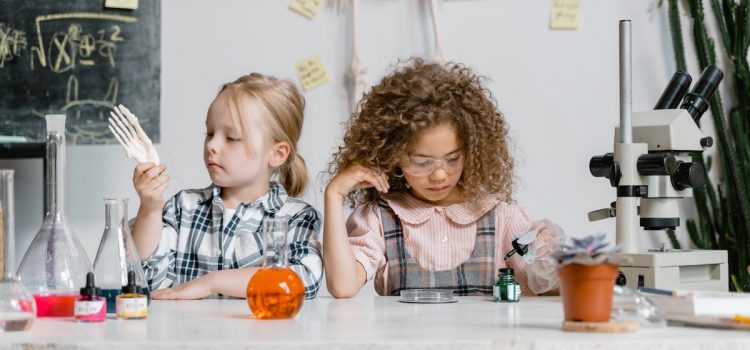

This article is an excerpt from the Shortform book guide to "The Gardener and the Carpenter" by Alison Gopnik. Shortform has the world's best summaries and analyses of books you should be reading.
Like this article? Sign up for a free trial here.
What is the observational learning theory? How do children learn from imitating others?
The observational learning theory proposes that children (and even adults) can acquire new knowledge simply by watching other people. In The Gardener and the Carpenter, Alison Gopnik explains how you as a parent can adjust your teaching patterns to support this type of learning in your children.
Learn more about how children pick things up by observing you, other children, and other adults.
Observational Learning and Imitation
The observational learning theory says that children observe others and learn from what they see, often imitating others’ behavior to learn more deeply. Children don’t have to be told that someone is teaching them something in order to learn. They learn not only activities that they see but also activities that adults do with them, and Gopnik implies that this is the best way to teach—not with the goal of creating knowledge, but with the goal of doing things together, which she describes as love in practice.
| Observational Learning: An Aspect of Social Learning Observational learning theory is a component of Social Learning Theory, which was proposed by Albert Bandura in the 1970s. One feature of this theory that Gopnik doesn’t address is that the behavior children learn from observation can be further shaped by others’ responses to that behavior. Specifically, a positive response from others will reinforce that behavior, making the child more likely to repeat it. Gopnik focuses heavily on the initial act of teaching, but Social Learning Theory suggests that adults may have more control over what children learn than Gopnik indicates because they can reinforce a child’s behavior. However, research into social learning does support Gopnik’s suggestion that teaching by doing is more effective than teaching to create knowledge, as children aren’t motivated by the prospect of gaining knowledge but rather by the immediate joy of doing something. |
Gopnik cites various studies that show how children learn through observation. Kids pay close attention to the intention behind a behavior—meaning they imitate not just the behavior itself but the goal behind the behavior. If they see an adult deliberately turn on the TV using a remote control, for example, they’re more likely to imitate that behavior than if they see an adult turn on the TV accidentally by sitting on the remote control. They also notice and come up with alternative ways of doing things, including ways to make an action more efficient—for instance, if they see someone taking unnecessary steps to accomplish something, they’ll often learn to eliminate those steps and streamline the process to achieve the goal.
| Caregivers Should Be Cautious About the Intentions They Model Gopnik shows how children focus on the intention behind an adult’s behavior when deciding whether to imitate it, which suggests that perhaps caregivers should themselves be more intentional about the intentions they and other significant adult figures model for them. If children see someone intentionally perform a harmful behavior, they might be more likely to imitate that behavior than if they see someone unintentionally do the same thing. For instance, you likely wouldn’t want your child to watch a group of teens intentionally destroying a playground—your child would recognize the purpose behind the action and might be driven to imitate it. Similarly, you might also want to be more cautious about the intentions you model: If your car won’t start and you begin angrily kicking the wheel with the intention of damaging the vehicle, your child might be tempted to model that purposeful behavior, too. What’s more, children may even find ways to more efficiently perform these harmful behaviors since they’re often able to eliminate unnecessary steps from processes. |
Overimitation
However, there are times when children will imitate unnecessary steps—which Gopnik refers to as overimitation. If they’re learning from someone who seems to be an expert—for example, someone who says “I know how this object works, let me show you,” versus “I don’t know how this object works, let’s figure it out”—they’ll imitate unnecessary steps as well. They also tend to experiment less when being taught by an “expert,” so they’re likely to come up with fewer alternative ways of doing things.
(Shortform note: Some psychologists don’t object to a child’s tendency to imitate unnecessary steps, arguing that such “overimitation” is a legitimate part of the learning process. A child can’t know which steps are unneeded until they’ve gone through all the steps and seen which brought about the desired outcome. This process helps them learn about cause and effect. Some also note that a child’s tendency to experiment less might be simply because when shown a process by an expert, that process typically leads to the desired outcome immediately, reducing the need for experimentation—which is not necessarily detrimental to the learning process.)
Probability
Gopnik’s research suggests that children will even take probability into account at ages when they’re too young to formally understand what probability is. Gopnik conducted a study in which children were shown a red and a blue block, and a machine that would play music when activated by one of the blocks. They visually demonstrated to the children that the blue block activated the machine more frequently than the red block and then asked the children if they could activate the machine. Children as young as two years old chose the blue block consistently, showing that they can use patterns and statistics to make predictions even without the ability to understand basic math.
(Shortform note: Additional research suggests that the age at which children can take probability into account is as young as six months as opposed to two years. It shows that babies pay more attention to extremely unlikely things (625 times less likely than the alternative) as opposed to things that are only slightly less likely (9 times less likely than the alternative), suggesting that babies can instinctively understand when events might be more or less likely to happen.)

———End of Preview———
Like what you just read? Read the rest of the world's best book summary and analysis of Alison Gopnik's "The Gardener and the Carpenter" at Shortform.
Here's what you'll find in our full The Gardener and the Carpenter summary:
- The difference between gardner and carpenter parenting styles
- Why parenting should not be a form of work but an act of love
- How the schooling model fails to effectively support children’s learning






